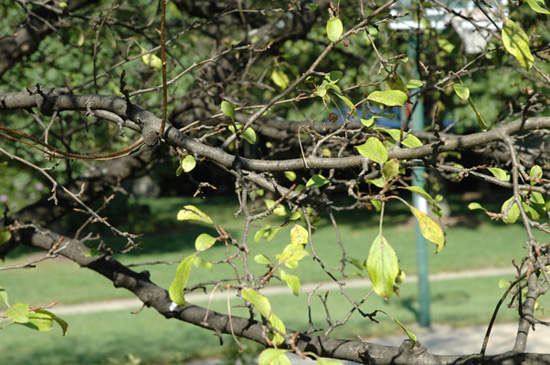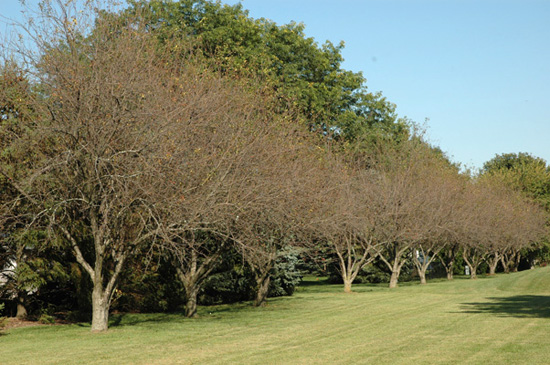Issue 16, September 14, 2009
Crabapple Scab Update
Crabapple scab has been more severe in Illinois this year than in any year in the last two decades. This disease has caused severe and early defoliation of most crabapples in the state. Only the most resistant varieties or those protected by fungicides have escaped the effects of scab this season. We discussed this disease in issue 5 this year, so refer to that article for details on scab.
Initial infection of the scab fungus each spring is via ascospores produced by the overwintering structures. These initial infections occur as leaf buds open in wet periods. Most of this initial infection is completed by 3-5 weeks after petal fall. Cool, wet spring weather always results in more scab infections.
Secondary infections are caused by a different type of spore, known as summer spores or scab conidia. These spores continue to infect as long as there are wet periods in the summer and in the autumn. Secondary infection is usually minimal under typical Illinois summer conditions. For much of Illinois the 2009 season provided frequent rain events and cool temperatures. The result was continual infection of new growth. Report on Plant Disease no. 803 discusses apple scab. Tables in that report show the wetness period for scab infection at different temperatures. The time period is less in cool weather.
The first photo shows a typical sparsely foliated crabapple branch as a result of multiple scab infections. The leaves that remain attached do not show typical scab infection like those on the ground under the tree. It is easy to see why the scab fungus might not be identified as the cause of defoliation. The second image shows a row of infected crabapple trees nearly completely defoliated by early September. You can see the deciduous trees behind this row of crabs are still fully leafed.


We do not know the ultimate effect of this severe scab year. We do know that susceptible crabapple trees show injury year after year and still survive. They are thought to be weakened by repeated infection and prone to injury by other diseases and insects. We have several suggestions. Remove fallen leaves this fall because the fungus is known to overwinter on fallen leaves. Remove dead wood (easily snaps when bent) as it appears. Water infected trees in extended periods of drought. Consider a balanced fertilizer in late fall or early spring to help tree vitality.--Nancy Pataky
Author:
Nancy Pataky